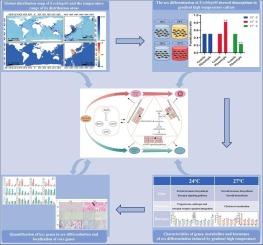Molecular characteristics of gonadal differentiation dimorphism in the ovoviviparous fish Sebastes schlegelii under gradient high-temperature induction
IF 4.9
3区 环境科学与生态学
Q1 ENVIRONMENTAL SCIENCES
引用次数: 0
Abstract
Global warming can alter fish sex ratios and threaten population stability, particularly in species with temperature-sensitive sex differentiation. Sebastes schlegelii, an ovoviviparous species adapted to both cold and warm waters, may exhibit feminization or masculinization under high temperatures. However, the underlying molecular mechanisms remain unclear. We hypothesized that high-temperature exposure activates distinct sex-differentiation pathways and sought to identify the key genes and metabolites involved. Our findings reveal a balanced sex ratio at 18 °C, a notable feminization at 24 °C with 83.3 % of individuals being female, and a significant masculinization at 27 °C where 76.7 % are male. Transcriptomic and metabolomic analyses revealed at 24 °C, pathways related to steroid hormone biosynthesis, estrogen signaling, and progesterone, androgen, and estrogen receptor agonists/antagonists were activated, whereas at 27 °C, activation was prominent in steroid hormone biosynthesis, steroid biosynthesis, and cholesterol metabolism. Key genes and metabolites included cyp7a1, cyp1a1, hsd17b1, hsd17b2, erα, creb1, hsp70, and Estrone at 24 °C, and cyp7a1, lipa, lss, and Taurocholic acid at 27 °C. Quantitative reverse transcription PCR (RT-qPCR) revealed upregulation of female differentiation genes (foxl2, cyp19a1) at 24 °C and male differentiation genes (sox9, amh, dmrt1, hsd11b2) at 27 °C. Hormonal assays showed elevated 17β-estradiol (E2) at 24 °C and 11-ketotestosterone (11-KT) at 27 °C. In situ hybridization (ISH) revealed that, in stage II gonads, sox9 and amh are predominantly localized in Sertoli cells of the testis. These findings support our hypothesis and demonstrate that high temperature drives sex differentiation in S. schlegelii through distinct molecular programs, identifying core regulators and pathways underlying temperature-sensitive sexual development.

梯度高温诱导下卵胎生鱼性腺分化二态性的分子特征。
全球变暖会改变鱼类的性别比例,威胁到种群的稳定,尤其是那些对温度敏感的性别分化物种。schlegelii是一种适应冷水和温水的卵胎生物种,在高温下可能表现出雌性化或雄性化。然而,潜在的分子机制尚不清楚。我们假设高温暴露激活了不同的性别分化途径,并试图确定其中的关键基因和代谢物。我们的研究结果表明,在18°C时性别比例平衡,在24°C时明显女性化,83.3%的个体是女性,在27°C时明显男性化,76.7%的个体是男性。转录组学和代谢组学分析显示,在24°C时,类固醇激素生物合成、雌激素信号、黄体酮、雄激素和雌激素受体激动剂/拮抗剂相关的途径被激活,而在27°C时,类固醇激素生物合成、类固醇生物合成和胆固醇代谢的激活尤为突出。关键基因和代谢物包括24℃时的cyp7a1、cyp1a1、hsd17b1、hsd17b2、erα、creb1、hsp70和雌酮,27℃时的cyp7a1、脂质、less和牛胆酸。定量反转录PCR (RT-qPCR)结果显示,雌性分化基因foxl2、cyp19a1在24°C上调,雄性分化基因sox9、amh、dmrt1、hsd11b2在27°C上调。激素检测显示,在24℃时17β-雌二醇(E2)升高,在27℃时11-酮睾酮(11-KT)升高。原位杂交(ISH)显示,在II期性腺中,sox9和amh主要定位于睾丸的支持细胞。这些发现支持了我们的假设,并证明高温通过不同的分子程序驱动schlegelii的性别分化,确定了温度敏感性发育的核心调节因子和途径。
本文章由计算机程序翻译,如有差异,请以英文原文为准。
求助全文
约1分钟内获得全文
求助全文
来源期刊

Marine pollution bulletin
环境科学-海洋与淡水生物学
CiteScore
10.20
自引率
15.50%
发文量
1077
审稿时长
68 days
期刊介绍:
Marine Pollution Bulletin is concerned with the rational use of maritime and marine resources in estuaries, the seas and oceans, as well as with documenting marine pollution and introducing new forms of measurement and analysis. A wide range of topics are discussed as news, comment, reviews and research reports, not only on effluent disposal and pollution control, but also on the management, economic aspects and protection of the marine environment in general.
 求助内容:
求助内容: 应助结果提醒方式:
应助结果提醒方式:


